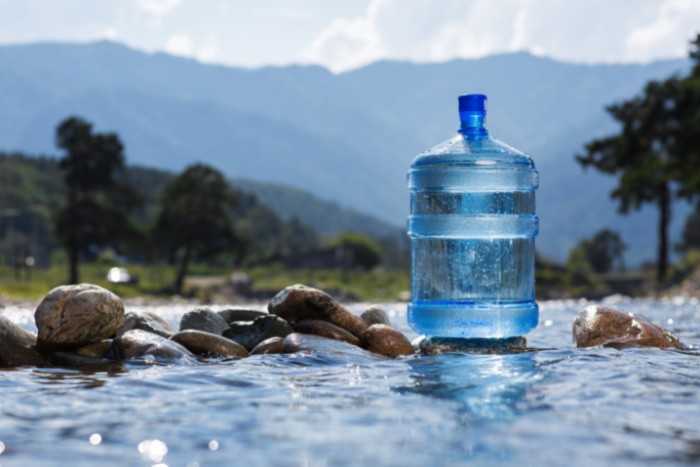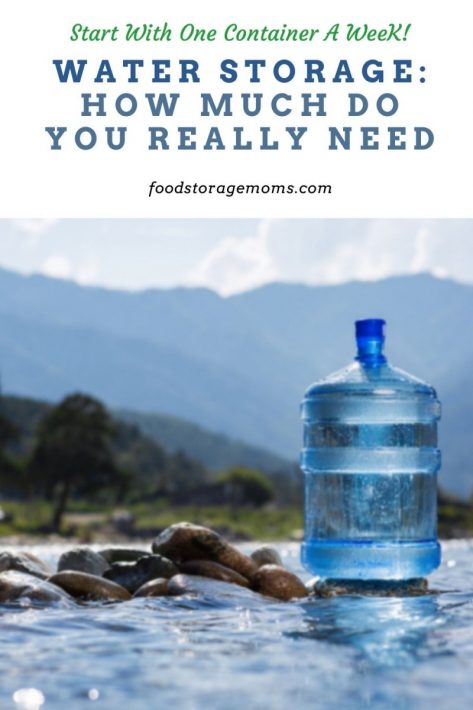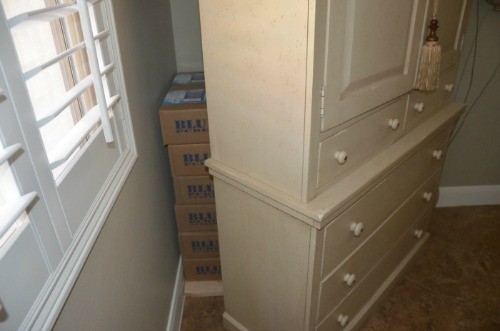
Today, it’s all about water storage; how much do you need? It may not be a popular opinion, but I’m all for having stored water for emergency water storage. The truth is that you never know when natural disasters or human-made disasters will occur. The American Red Cross states that to be adequately prepared, we need one gallon per person daily. I get thirsty just typing that statement.
I struggle when I think of families trying to survive a disaster with only one gallon per person daily. You may be okay with a pinch for a couple of days, but I think that amount spells trouble for a more extended period. I strongly suggest you have four gallons of water storage per person per day. It’s a good idea to store drinkable and potable water in case of a major disaster.

Long-Term Water Storage
I decided I needed to update this post based on all the talk about the drought here in the West and the history of floods in the eastern states. Here’s the deal: I can almost bet you we will need to share our water storage with a few neighbors, friends, or family who didn’t store enough for their family besides just trying to get your family through the challenging period.
I received a comment from someone named Maritza a few years ago in Puerto Rico, and I have to tell you that her comment melted my heart.
I have to share it: “Hi, I am from Puerto Rico, and thanks to your advice, I started a food and water storage that allowed us as a family of 6 to endure Hurricane Maria’s aftermath. Thank you so much for sharing your knowledge!!!”
I have never met her, but I admire her tenacity to be prepared for the unexpected. I was answering her comment, and the Ellen DeGeneres show was on TV featuring Ricky Martin, also from Puerto Rico. He showed the world how much the people there needed so many items!
What are the odds that I would have that show on at the very minute I answered Maritza’s comment? If I ever can go there, I want to hug this fantastic woman, Maritza! I want to talk to you about your emergency water supply and how much you need to store.
Water Storage-How Much Do You Need
Please Store Water: Emergency Situation
Sometimes, I get on the bandwagon, so to speak, about water storage. I feel strongly that I need to share my ideas of how to store water and lots of it. The other day, I looked on the Internet at the 3.5-gallon blue WaterBricks, and it said they are currently unavailable. Please keep checking to see when they are available.
Today, they are available, but I don’t know how long they will stay. It appears the prices have gone up, too. The supply chain issues in the global economy are affecting many people!
I’m assuming maybe people are now aware of how quickly water can’t be purchased in grocery stores once they hear about a pending storm or soon after it has passed by. WaterBricks and WaterBrick Spigot.
WaterBricks for Water Storage
I used to store several of these under my guest bedroom queen bed. This gives you an idea of how to store some, and they also stack on each other to help save room. They are lined up against my bedroom wall in our new home.
Each WaterBrick holds 3.5 gallons (the larger ones), weighing about 27 pounds each when filled with water. If you consider using these, they hold 3.5 gallons, almost enough water storage for one person daily. Do you have four people in your family? You need 16 of these for you to have coverage for four days. If you want seven days’ worth of water storage for four people, you need 28 WaterBricks.
Please remember to fill your containers with a lead-free hose if you fill them outside with your house faucet. Use a lead-free hose and water preserver so you only have to rotate the water every five years. If you use bleach, you need to rotate every six months. One 3.5-gallon WaterBrick unit needs 1/2 teaspoon of Water Preserver for each container.
One significant advantage to the Water Bricks is that I can lift them easily. I found that 5-gallon containers were too heavy to move around quickly. The 3.5-gallon units were okay, but I could not move them long-distance if they were full.
Barrels for Water Storage
I recently saw 55-gallon water barrels at a Hurricane, Utah, store for just under $40.00. That’s cheaper than I have seen in years. These need a bung to close the cap and a pump to pump the water out when water is required. BUNG and WATER PUMP
Sometimes, you can get some of these barrels at Walmart. They are also available at Emergency Preparedness/Be Prepared and Amazon. They are expensive online. Typically, the bungs and pumps are right next to the barrels. You would use one full container of Water Preserver in each unit.
Mark and I wondered how difficult it was to use the pump in the barrel. We needed to move one of the barrels since the pallet it was stacked on had broken and needed to be replaced. Mark removed the cap, put it in the pump, and started pumping.
To his surprise, the pump acted like a siphon, and the water kept running without the pump being activated again. He had to repeat this a couple more times, but that barrel was empty in about 20 minutes without much pumping action.
Water Storage in Bottles
We can buy cases of water at the grocery store that come in 24 bottles or more to a case. These are fine as long as you rotate them. Please keep them stored out of direct sunlight. You would need to calculate how many ounces are in the brand you buy and decide how many cases your family needs for each day.
Any clean water stored is better than no water at all. Please remember to buy a little at a time and keep adding to your inventory as budgets and space allow. Before long, you will have 30 days or more of water.
The small bottles work fine for drinking and cooking, even though you’ll go through them relatively fast. The challenge comes when you need some “personal hygiene” attention, even if it’s just a sponge bath. The other challenge is if it’s time to wash a few pieces of underwear. You’ll go through those cases pretty quickly.
Best Solution: Blue Cans
This product is by far one of the best containers to store water. They will last 50 years and taste better than any water you’ll taste anywhere. You don’t have to pay for the shipping if you live near a distributor.
Almost every time I talk about these, I get a few remarks about how expensive they are. Yes, they are costly, but they are worth every penny.
I have 18 cases stored behind a dresser in my bedroom. I can sit and forget them and sleep at night knowing I have water for Mark and me, at least for drinking and cooking when needed. If you’re looking into emergency preparedness, start with water! These blue cans will change how you look at long-term storage for water.
Blue Can Water (continued)
I recently took a 24-pack case to a subdivision, asking me to discuss food and water storage. The people were in awe over the BlueCans of water. I don’t sell them, although I would like to buy a pallet and send it here and have a few families split the cost.
I couldn’t get anyone in my neighborhood to go in on a pallet, but this other subdivision is trying to figure out how many to order. If you live near any of these distributors, you may want to set aside and forget a few cases, but I promise you won’t be sorry.
I found one place that sells for less than anywhere else: Brownells (sold out right now)
If you are starting your food and water storage journey, please start with my book if you haven’t purchased it yet: “Prepare Your Family For Survival”
If you want to get serious about water storage, you can buy storage tanks with large quantities of water. The challenge is finding a place to store the tanks and having a way to treat the water (see Water Preserver above). We have a 160-gallon tank in one corner of the garage and a 250-gallon unit in another corner.
I feel prepared with these large tanks full and ready to dispense water when needed, and with the Water Preserver, I only have to empty and refill the tanks every five years.
These tanks have spigots at the bottom, so you can empty them or draw a few gallons when needed. I emptied and refilled one of the tanks only when I hooked a hose to one of the spigots and drained the water into my flower beds. Remember that long-term water storage doesn’t happen by accident; you must be intentional about the amount of water you store!
Where else can I store water?
Now, these options aren’t for super long periods of water storage. However, if you have a warning (like a hurricane warning), you can quickly fill up containers like this for flushing water or cooking.
- Liter soda bottles
- Juice bottles
- Stainless steel bottles
- Gallon jugs
- A hot water tank or water heater
- Swimming pool (pool water)
- Reuse water bottles
- Any type of clean containers that you have are great for storing water in an emergency (milk plastic bottles crack after a while)
Food-grade plastic containers are preferred! Don’t forget that you’ll need water for emergencies that may come your way. Sometimes, you only have a few hours to assemble last-minute potable water storage, and these containers work great.
More Water Storage Tips
- The Best Water Storage Containers
- Why You Need Emergency Water Storage
- How to Barter with Food and Water
Final Word
Thanks again for being prepared for the unexpected. Please get your water storage to the level you feel necessary so you won’t have to stand in line at the store or wait for the government or another group to hand out cases of water.
I suggest you try the options outlined above to see which water storage containers work best for you and your family. We are so used to being able to turn the water faucet on and off. Please think again. Remember that this post is a good starting point for storing water and using water containers. May God bless this world, Linda
Copyright Images: Water Jug AdobeStock_223202040 by arttim
The post Water Storage: How Much Do You Really Need? appeared first on Food Storage Moms.
from Food Storage Moms

No comments:
Post a Comment